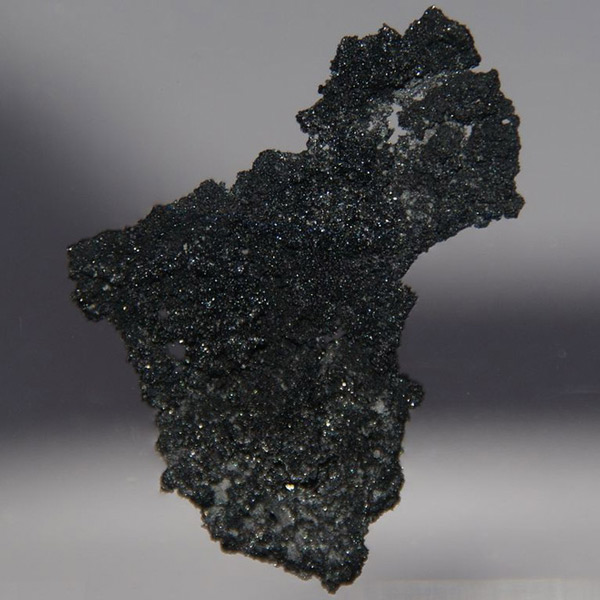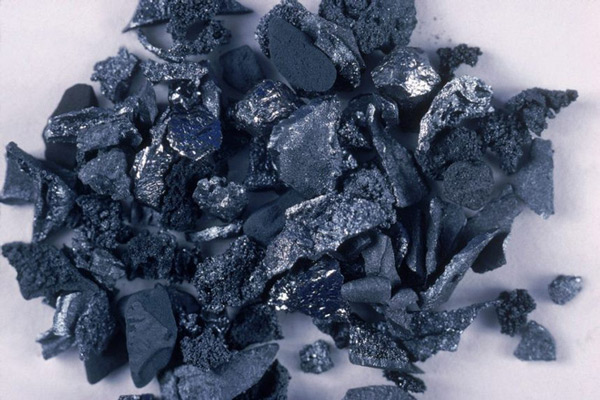Not graphene, borophene is the magic material of the future, the new darling of science
Graphene is an extremely strong carbon sheet, thickness by atomic diameter, capable of 'transforming' into different shapes and can conduct electricity. These capabilities make graphene honored by the world's scientific community as the marvelous material of the future, which can open a new era for computer microprocessors. In order to stimulate the development of the graphene industry, the EU alliance has spent almost 1 billion euros.
Although the graphene dream has not yet come true, it also helps scientists find new materials. The most prominent is borophene, a thin layer of boron atom can be classified into many different crystal structures, can be applied to many industries, used for many different purposes.

A block of borophene.
Electrochemists say that using borophene in the production of anode can create a new generation lithium-ion battery. Meanwhile, experimental physicists use borophene to search for many types of atoms and molecules.
Since the 1990s, physicists have predicted the existence of borophene through a program that simulates how boron atoms merge into a thin layer of boron.
By 2015, by depriving hot gas from concentrated boron molecules to a cold surface made of pure steel, the scientists synthesized borophene.
Boron atoms are squeezed according to the arrangement of iron atoms, with each of the six atoms joined together into a hexagon. However, a large proportion of boron atoms have a different, more specific structure, with only 4 or 5 atoms joining together to form holes in the hexagonal structure. That same hole makes the borophene special.

Borophene is an artificial product, so scientists have conducted many different tests to give it more unique properties. From those tests, scientists have discovered that borophene is even more solid and flexible than graphene. In addition, borophene also has superconducting properties, which can transmit electricity and heat very well.
It is the gaps in the borophene structure that create these properties. Changing gaps is to change properties.
In addition to these properties, borophene is very light and reacts well to many substances. Therefore, scientists consider borophene to be a candidate for ion storage in batteries.
Borophene can also become an effective hydrogen storage tool because hydrogen atoms can easily adhere to the borophene structure. Hypothetical studies show that borophene is superior to any other material in terms of its ability to contain hydrogen, with up to 15% of its own mass.

Another possibility of borophene is catalysis, which separates hydrogen atoms into hydrogen ions, separating water into ions of hydrogen and oxygen. This makes borophene can be used to generate energy from water with greater efficiency than ever before.
It is the reaction of borophene that makes it easy to oxidize, which makes it difficult to experiment. Scientists need to study to overcome this weakness of it. However, they still cannot produce bulk borophene for testing and application. There is a lot of work to do before the makers of borophene become promising materials.
You should read it
- Lithium-Sulfur batteries will help smartphones work longer
- Decode the mystery of the Mpemba effect
- Building the hair of the mysterious death of nine Soviet scientists
- Scientists find the true cause of the giant animal extinction in Australia
- Scientists teach AI to diagnose brain cancer
- For the first time, scientists have successfully implemented quantum shifts between two chips
- Science has discovered giant viruses with the ability to 'steal' other species' characteristics
- Scientists develop brain scanners like helmets
May be interested
- 5 reasons why Magic Trackpad is better than Magic Mouse
 apple knows how to create a compelling product. there has never been a product as beautiful as the magic trackpad 2. but for an additional $ 50, is it worth buying the magic mouse instead?
apple knows how to create a compelling product. there has never been a product as beautiful as the magic trackpad 2. but for an additional $ 50, is it worth buying the magic mouse instead? - Mobile phone screens will be able to recover when cracked or scratched in the next few years
 a team of researchers from california riverside university invented a material that is thought to be able to repair itself when cracked or scratched. this material is made of flexible polymers and ionic salts, and it can be extended to about 50 times its original size.
a team of researchers from california riverside university invented a material that is thought to be able to repair itself when cracked or scratched. this material is made of flexible polymers and ionic salts, and it can be extended to about 50 times its original size. - Flipping the magic trick suspended above does not have magic
 the magician has created a performance hovering in the air from sticking his hands on the wall to fastening himself to the bus, causing the audience to be amazed and curious to discover. find out what they use 'magic magic' in this unique magic show.
the magician has created a performance hovering in the air from sticking his hands on the wall to fastening himself to the bus, causing the audience to be amazed and curious to discover. find out what they use 'magic magic' in this unique magic show. - Decode classic magic tricks in the world
 after reading this lesson, you will realize that just turning out magic is just that simple.
after reading this lesson, you will realize that just turning out magic is just that simple. - Decode 6 magic tricks that challenge all the laws of physics in the world
 with the bizarre magic tricks below, you will find them challenging all the laws of physics in this world, turning the impossible into possible.
with the bizarre magic tricks below, you will find them challenging all the laws of physics in this world, turning the impossible into possible. - Science warns: Sea levels may rise more than three meters in the future
 scientists have just officially warned that sea level could rise to three meters in the future.
scientists have just officially warned that sea level could rise to three meters in the future. - Swiss researchers found new organic luminescent material
 the newly discovered luminescent material is cheap, efficient and can become an alternative light source in the future.
the newly discovered luminescent material is cheap, efficient and can become an alternative light source in the future. - How computers will be used in the future
 intel corporation is conducting a number of experimental studies to help scientists show how people will use computers in the future.
intel corporation is conducting a number of experimental studies to help scientists show how people will use computers in the future. - Reveal 8 'immortal' magic tricks - the only thing you see turned out to be no magic at all!
 if you look at these pictures, you will understand how we are being fooled in the immortal magician's magic tricks. reveal 8 immortal magic tricks - the only thing you see turns out there's no magic at all!
if you look at these pictures, you will understand how we are being fooled in the immortal magician's magic tricks. reveal 8 immortal magic tricks - the only thing you see turns out there's no magic at all! - Code Fairy Tail Magic Era Latest
 fairy tail magic era is a game developed on the roblox platform inspired by the cult fairy tail series. in particular, players can use the following game codes to increase their strength and become the top mage that any guild wants to acquire.
fairy tail magic era is a game developed on the roblox platform inspired by the cult fairy tail series. in particular, players can use the following game codes to increase their strength and become the top mage that any guild wants to acquire.










 Labeled with the bullet being cut in half, shooting two balls at 28,500 frames per second
Labeled with the bullet being cut in half, shooting two balls at 28,500 frames per second This is why touching a 200,000V electric ball without shocking and putting a hand into the 120V electric drive is dead
This is why touching a 200,000V electric ball without shocking and putting a hand into the 120V electric drive is dead If you solve this puzzle, you're better than Japanese physics professor!
If you solve this puzzle, you're better than Japanese physics professor! 19 familiar phenomenon that everyone can see but 'lazy to ask Google doctor' why
19 familiar phenomenon that everyone can see but 'lazy to ask Google doctor' why Can you solve the puzzle that all astronauts must pass before entering this universe?
Can you solve the puzzle that all astronauts must pass before entering this universe? The interesting scientific knowledge that we missed while at school
The interesting scientific knowledge that we missed while at school